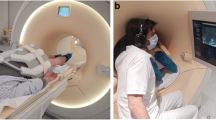Abstract
Purpose
To evaluate the technical and clinical utility of a fully MRI-compatible, pneumatically driven remote-controlled manipulator (RCM) for targeted biopsies of the prostate at 1.5 T.
Materials and methods
The data of the first 22 patients that were biopsied under robotic assistance were analyzed. Interventional planning relied on T2-weighted (T2w) turbo spin-echo (TSE) images (axial and sagittal) with a high-b-value diffusion-weighted acquisition added in selected cases. Alignment of the needle guide was controlled with a short balanced SSFP sequence in two oblique planes along the MR-visible sheath. Signals were acquired with a combination of elements from a 30-channel body and a 32-channel spine coil. Biopsy samples were taken with a fully automatic 18-G biopsy gun with a length of 150 or 175 mm.
Results
Mean age was 66.6 years and average PSA level was 11.5 ng/ml. Fourteen out of 22 patients (63%) had received prior biopsies under transrectal ultrasound guidance. Diagnostic MRI reports (before biopsy) involved 17 cases with a single suspicious finding (four PI-RADS 3, one PI-RADS 3–4, eight PI-RADS 4 and nine PI-RADS 5 cases). The median effective procedure time was 33.9 (range 25.0–55.9) min for 16 cases with one CSR and 63.4 (52.7–81.8) min for 5 cases with two CSRs. The biopsy with three CSRs took 74.0 min. Histopathologic examination revealed prostate cancer in 14 of 22 cases.
Conclusion
MR-targeted, transrectal biopsy of the prostate could be reliably performed with a robotic manipulator at a field strength of 1.5 T. Balanced SSFP imaging is considered a viable option for fast procedural control. Follow-up work needs to evaluate to what extent in-bore adjustments and workflow enhancements will contribute to shorter procedure times or higher patient comfort.



Similar content being viewed by others
Abbreviations
- bSSFP:
-
Balanced steady-state free precession
- BPH:
-
Benign prostate hyperplasia
- CSR:
-
Cancer-suspicious region
- DCE:
-
Dynamic contrast-enhanced
- FOV:
-
Field-of-view
- MR-TRUS-TB:
-
MR-TRUS fusion biopsy
- MR-TB:
-
MR-targeted biopsy
- PZ:
-
Peripheral zone
- PCa:
-
Prostate cancer
- PI-RADS:
-
Prostate imaging reporting and data system
- PSA:
-
Prostate-specific antigen
- RCM:
-
Remote-controlled manipulator
- T2w:
-
T2-weighted
- TSE:
-
Turbo spin-echo
- TZ:
-
Transitional zone
- TRUS:
-
Transrectal ultrasound
- TRUS-B:
-
TRUS-guided biopsy
References
Global Burden of Disease Cancer Collaboration, Fitzmaurice C, Akinyemiju TF, Al-Lami FH, Alam T, Alizadeh-Navaei R, Allen C, Alsharif U, Alvis-Guzman N, Amini E, Anderson BO, Aremu O, Artaman A et al (2018) Global, regional, and national cancer incidence, mortality, years of life lost, years lived with disability, and disability-adjusted life-years for 29 cancer groups, 1990–2016: a systematic analysis for the global burden of disease study. JAMA Oncol 4:1553–1568
Kasivisvanathan V, Rannikko AS, Borghi M, Panebianco V, Mynderse LA, Vaarala MH, Briganti A, Budäus L, Hellawell G, Hindley RG, Roobol MJ, Eggener S et al, for the PRECISION Study Group Collaborators (2018) MRI-targeted or standard biopsy for prostate-cancer diagnosis. N Engl J Med 378:1767–1777
Kaiser WA, Fischer H, Vagner J, Selig M (2000) Robotic system for biopsy and therapy of breast lesions in a high-field whole-body magnetic resonance tomography unit. Invest Radiol 35:513–519
Pfleiderer SOR, Reichenbach JR, Azhari T, Marx C, Malich A, Schneider A, Vagner J, Fischer H, Kaiser WA (2003) A manipulator system for 14-gauge large core breast biopsies inside a high-field whole-body MR scanner. J Magn Reson Imaging 17:493–498
Krieger A, Susil RC, Ménard C, Coleman JA, Fichtinger G, Atalar E, Whitcomb LL (2005) Design of a novel MRI compatible manipulator for image guided prostate interventions. IEEE Trans Biomed Eng 52:306–313
DiMaio SP, Pieper S, Chinzei K, Hata N, Haker SJ, Kacher DF, Fichtinger G, Tempany CM, Kikinis R (2007) Robot-assisted needle placement in open MRI: system architecture, integration and validation. Comput Aided Surg 12:15–24
Stoianovici D, Song D, Petrisor D, Ursu D, Mazilu D, Mutener M, Schar M, Patriciu A (2007) “MRI Stealth” robot for prostate interventions. Minim Invasive Ther Allied Technol 16:241–248
Van den Bosch MR, Moman MR, Van Vulpen M, Battermann JJ, Duiveman E, van Schelven LJ, de Leeuw H, Lagendijk JJ, Moerland MA (2010) MRI-guided robotic system for transperineal prostate interventions: proof of principle. Phys Med Biol 55:N133–140
Krieger A, Iordachita II, Guion P, Singh AK, Kaushal A, Menard C, Pinto PA, Camphausen K, Fichtinger G, Whitcomb LL (2011) An MRI-compatible robotic system with hybrid tracking for MRI-guided prostate intervention. IEEE Trans Biomed Eng 58:3049–3060
Zangos S, Herzog C, Eichler K, Hammerstingl R, Lukoschek A, Guthmann S, Gutmann B, Schoepf UJ, Costello P, Vogl TJ (2007) MR-compatible assistance system for punction in a high-field system: device and feasibility of transgluteal biopsies of the prostate gland. Eur Radiol 17:1118–1124
Zangos S, Melzer A, Eichler K, Sadighi C, Thalhammer A, Bodelle B, Wolf R, Gruber-Rouh T, Proschek D, Hammerstingl R (2011) MR-compatible assistance system for biopsy in a high-field-strength system: initial results in patients with suspicious prostate lesions. Radiology 259:903–910
Beyersdorff D, Winkel A, Hamm B, Lenk S, Loening SA, Taupitz M (2005) MR imaging–guided prostate biopsy with a closed MR unit at 1.5 T: initial results. Radiology 234:576–581
Felker ER, Lee-Felker SA, Feller J, Margolis DJ, Lu DS, Princenthal R, May S, Cohen M, Huang J, Yoshida J (2016) In-bore magnetic resonance-guided transrectal biopsy for the detection of clinically significant prostate cancer. Abdom Radiol 41:954–962
Yakar D, Schouten MG, Bosboom DGH, Barentsz JO, Scheenen TWJ, Fütterer JJ (2011) Feasibility of a pneumatically actuated MR-compatible robot for transrectal prostate biopsy guidance. Radiology 260:241–247
Schouten MG, Bomers JGR, Yakar D, Huisman H, Rothgang E, Bosboom D, Scheenen TWJ, Misra S, Fütterer JJ (2012) Evaluation of a robotic technique for transrectal MRI-guided prostate biopsies. Eur Radiol 22:476–483
Bomers JGR, Bosboom DGH, Tigelaar GH, Sabisch J, Fütterer JJ, Yakar D (2017) Feasibility of a 2nd generation MR-compatible manipulator for transrectal prostate biopsy guidance. Eur Radiol 27:1776–1782
Busse H, Kahn T, Moche M (2018) Techniques for interventional MRI guidance in closed-bore systems. Top Magn Reson Imaging 27:9–18
Greer MD, Brown AM, Shih JH, Summers RM, Marko J, Law YM, Sankineni S, George AK, Merino MJ, Pinto PA, Choyke PL, Turkbey B (2017) Accuracy and agreement of PIRADSv2 for prostate cancer mpMRI: a multireader study. J Magn Reson Imaging 45:579–585
Sonn GA, Fan RE, Ghanouni P, Wang NN, Brooks JD, Loening AM, Daniel BL, To'o KJ, Thong AE, Leppert JT (2017) Prostate magnetic resonance imaging interpretation varies substantially across radiologists. Eur Urol Focus. https://doi.org/10.1016/j.euf.2017.11.010
Liddell H, Jyoti R, Haxhimolla HZ (2015) mp-MRI prostate characterised PIRADS 3 lesions are associated with a low risk of clinically significant prostate cancer—a retrospective review of 92 biopsied PIRADS 3 lesions. Curr Urol 8:96–100
Tonttila PP, Lantto J, Pääkkö E, Piippo U, Kauppila S, Lammentausta E, Ohtonen P, Vaarala MH (2016) Prebiopsy multiparametric magnetic resonance imaging for prostate cancer diagnosis in biopsy-naive men with suspected prostate cancer based on elevated prostate-specific antigen values: results from a randomized prospective blinded controlled trial. Eur Urol 69:419–425
Felker ER, Raman SS, Margolis DJ, Lu DSK, Shaheen N, Natarajan S, Sharma D, Huang J, Dorey F, Marks LS (2017) Risk stratification among men with prostate imaging reporting and data system version 2 category 3 transition zone lesions: is biopsy always necessary? AJR Am J Roentgenol 209:1272–1277
Schoots IG (2018) MRI in early prostate cancer detection: how to manage indeterminate or equivocal PI-RADS 3 lesions? Transl Androl Urol 7:70–82
Gómez Rivas J, Giganti F, Álvarez-Maestro M, Freire MJ, Kasivisvanathan V, Martinez-Piñero L, Emberton M (2018) Prostate indeterminate lesions on magnetic resonance imaging-biopsy versus surveillance: a literature review. Eur Urol Focus. https://doi.org/10.1016/j.euf.2018.02.012
Author information
Authors and Affiliations
Contributions
NL, AS, MM and HB designed the study. NL, AS, TP, NB, PS, LH, JS and HB performed the acquisition of data. NL and HB analyzed and interpreted the data. NL and HB drafted the manuscript. Critical revision was provided by LH, JS, TK and MM
Corresponding author
Ethics declarations
Conflict of interest
HB has received a speaker honorarium from Siemens Healthcare, Germany. All other authors of this manuscript declare no relationships with any companies, whose products or services may be related to the subject matter of the article.
Ethical approval
Retrospective analysis was approved by the Institutional Review Board at the Medical Faculty of the University of Leipzig.
Informed consent
All patients provided (written) informed consent for the procedure.
Additional information
Publisher's Note
Springer Nature remains neutral with regard to jurisdictional claims in published maps and institutional affiliations.
Rights and permissions
About this article
Cite this article
Linder, N., Schaudinn, A., Petersen, TO. et al. In-bore biopsies of the prostate assisted by a remote-controlled manipulator at 1.5 T. Magn Reson Mater Phy 32, 599–605 (2019). https://doi.org/10.1007/s10334-019-00751-5
Received:
Revised:
Accepted:
Published:
Issue Date:
DOI: https://doi.org/10.1007/s10334-019-00751-5




